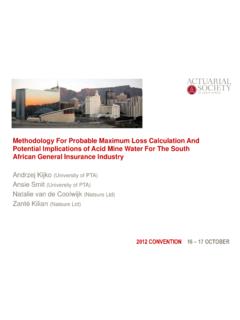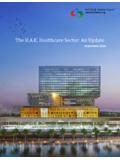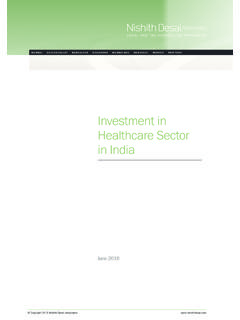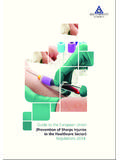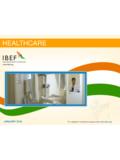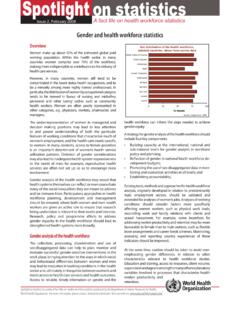Transcription of South African Healthcare Financing
1 THE BEGINNER'S GUIDE TO HEALTH CARE IN. South AFRICA. Some South African indicators (2002). Infant mortality rate (per 1000) 59. Under 5 mortality rate (per 1000) 100. Adult mortality rate (45q15). Males (%) 56. Females (%) 43. Life expectancy (e0). Males Females Sources of Healthcare Finance in South Africa South Africa currently spends % of GDP on Healthcare . This is relatively high by international standards. However, there are clear inequalities in the extent to which different sections of the South African population is able to access Healthcare services. The main sources of finance for Healthcare are: Government; households; employers and Non- Governmental Organisations (NGOs). Government is the largest source of Healthcare finance. Money is allocated to Healthcare from tax revenue and largely funds the delivery of public sector Healthcare services at provincial level. Government also provides a tax benefit those who purchase private health care cover through medical schemes.
2 The second largest source of health finance is household spending. This Financing takes place via contributions to medical schemes, direct out-of-pocket expenditure and to a limited extent to other forms of private insurance. Even households with private cover make out-of-pocket payments for services that are not fully covered. Employers fund Healthcare for their employees either directly through health services provided at the workplace or indirectly through contributions to medical schemes on behalf of their employees. Donors and Non-Governmental Organisations provide only a small proportion of Healthcare Financing in South Africa. This has increased since 1994 and with donor funding targeted at specific diseases such as malaria, tuberculosis and HIV/AIDS. -1- Pooling of Healthcare Financing in South Africa The allocation of Healthcare expenditure per person for the 2003 period is estimated as follows: Health expenditure in South Africa 2003/4.
3 Public Private Sector Sector Total expenditure (Rbn) 37 43. % of expenditure 46% 54%. Population covered (thousands) 38 541 6 962. % of population 85% 15%. Expenditure per person pa (2003 Rand R960 R6 176. values). Source: Department of Health South Africa has a fiscal federal system with considerable autonomy in spending at provincial level. Roughly 80% of the health budget is allocated by the nine provincial governments from an unconditional grant allocated from central government. Despite the allocation of an equitable share of the unconditional grant to all provinces equity has not been achieved in the provision of health services. Provincial allocations also fail to keep pace with population increases. There are strong arguments to recentralise the budget for Healthcare . Medical schemes are the dominant vehicles for providing risk-pooling for Healthcare in the private sector. Medical schemes are mutual funds usually managed by third party administrators and managed care organisations.
4 They offer benefits on a basis that defrays medical expenses (indemnity). The National Health Accounts for 1998 showed that direct expenditure on medical schemes amounted to of total private health expenditure, but this increased to when out-of-pocket payments by members was included. Health insurance polices provide non-indemnity benefits for specified health events. This means that the insurer provides a pre-determined amount of money on the occurrence of the event, rather than reimbursing the actual cost of Healthcare . The term health insurance has a particular meaning in South Africa and covers only the products delivered by the long- and short-term insurance industries. Purchasing and Delivery of Healthcare The South African Government has various policies to improve access to public primary Healthcare . This means that there have been increases in allocations by provinces to primary Healthcare services such as clinics, health centres, public health programmes and outpatient departments at district hospitals.
5 The funding of tertiary care and academic hospitals has therefore been under substantial strain. Increasing prevalence of HIV/AIDS in the South African population has meant increased pressure on budgeted Healthcare allocations. This impact is very different across provinces. Out-of-pocket expenditure by households that are not covered by medical schemes tends to be sued to seek private primary care so as to avoid waiting in long queues at the public clinic. -2- There are substantial inequities between resources in the public and private sectors. The table below demonstrates the number of providers per 100 000 lives in 2004. Provider Public Sector Private Sector Doctors Nurses Pharmacists Source: Health Systems Trust Medical schemes are not restricted to using private sector Healthcare providers. They can, in some provinces, contract with the public sector for the delivery of hospitalisation and chronic medicine to their members.
6 Primary care for medical scheme members is available only from private sector providers. Medical schemes may own their own clinics or hospitals and employ providers directly but this is a rare occurrence outside the mining industry. Health insurance products may not pay Healthcare providers directly and can only provide for the payment of an amount to the policyholder. Future Vision for Healthcare Financing in South Africa The Department of Health is in the process of implementing a system of Social Health Insurance (SHI). for South Africa. The previous Director General of Health, Dr Ayanda Ntsaluba, described these reforms in July 2003 as a very significant change in the structure of Healthcare Financing in this country . The future vision for the South African Healthcare system was outlined in the Report of the Social Security Committee of Inquiry (the Taylor Committee), released in May 2002. A more detailed discussion document on Healthcare was also released by the Department of Health (2002).
7 These reports recommended that South Africa move ultimately towards a Social Health Insurance system that integrates the public sector and private medical schemes in a universal contributory system. Under Social Health Insurance, only those that contribute receive benefits. Under National Health Insurance the taxpayers contribute but all citizens are entitled to the same defined package of benefits. The four phases of reform of private sector Healthcare have an initial goal of a Social Health Insurance system. Once the country has reached SHI system the question of its extension to NHI will require further deliberation and debate. The high levels of unemployment are a barrier to the direct implementation of NHI. South Africa's HIV Challenge The Actuarial Society of South Africa released a publicly available AIDS projection model in 1996. The model was primarily designed to make users aware of the likely impacts of the epidemic on mortality and morbidity and was calibrated using the limited available statistics.
8 The latest release is ASSA2003. and has had significantly more data sources to draw upon. It is estimated that some million South Africans are HIV positive 346 000 AIDS deaths are anticipated for 2006 and 527 000 new infections. So the epidemic is still growing. Approximately 580. 000 people are estimated to be eligible for anti-retroviral therapy with just over 100 000 receiving treatment from the government funded programme and a further 80 000 through medical schemes and corporate-funded programmes. The HIV prevalence in medical schemes is lower than in the general population as a result of the select nature of the group but HIV is still an important risk factor and treatment for HIV is included in the prescribed minimum benefits for medical schemes. -3.
